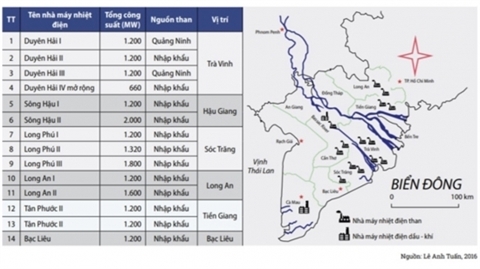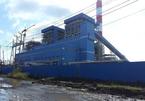Nguyen Huu Thien, an independent expert on Mekong Delta’s ecology, has presented a report on the negative impact of the development of coal-fired thermopower plants on aquatic resources in the region.

Coal-fired thermopower projects in Mekong Delta
He warned that coal-fired thermopower plants will cause thermal pollution to the water environment, thereby affecting the ecosystem and aquatic resources in the Mekong Delta.
The water for power plants is taken directly from Hau and Tien Rivers. After it is used to cool machines, it returns to the rivers with a temperature higher by 7oC, causing thermal pollution. This worsens water quality.
If Vietnam doesn’t restrict the number of coal-fired power plants, in 2020-2050, the total volume of cooling water would increase by 21.8 billion cubic meters, or 4.5 percent of Mekong’s total water volume of 475 billion cubic meters per year.
| Aquaculture is one of the economic pillars and important livelihoods of the Mekong Delta. However, it is threatened by coal-fired thermopower plants. |
The volume of Mekong water entering the Vietnamese territory changes greatly by season and year by year.
According to the National Meteorological Center, the total flow of the six months in the dry season in Mekong Delta in 1994 - 2012 was 150 billion cubic meters at the highest and 79 billion cubic meters at the lowest. Of this, the flow through Hau River accounts for 49 percent, or 73 billion cubic meters.
Thien estimated that at Long Phu Thermopower Center on Tran De feeder, the temperature could be up to 31.8-32.07oC, which may seriously affect aquatic resources.
Many hydropower plants are being built on Tran De feeder. Estuaries are one of the richest fisheries resources. Many aquatic species move in and out through estuaries, from the sea to the river and from the river to the sea. The damages caused by thermal pollution remain immeasurable, but are certainly very high.
These figures have been calculated based on normal weather conditions. In special cases, especially in drought conditions as in 2016, the influences would be more severe.
Supercritical technology is considered the most advanced technology applied at thermopower plants. The biggest advantage of the technology is that it emits less ash and dust, and is believed to cause minimum impact on the environment.
However, Thien believes that the technology cannot prevent thermal pollution. If many power plants discharge cooling water into the same water bodies, the total thermal pollution will still exceed the level the ecosystem can bear.
In natural environments, aquatic organisms live and grow within a narrow range of temperature, and some heat-sensitive species will die from changes in temperatures.
Chi Mai

Social organizations propose to stop licensing new coal-fired thermopower projects
Since the government is pursuing a consistent policy not to sacrifice the environment for economic development, coal-fired thermopower projects will no longer be developed.

Thermopower plants, coal consumers and air polluters
While developed countries are cutting the number of coal-fired thermopower plants for fear about environment pollution, Vietnam is still building more plants.
 Aquaculture is one of the economic pillars and important livelihoods of the Mekong Delta. However, it is threatened by coal-fired thermopower plants.
Aquaculture is one of the economic pillars and important livelihoods of the Mekong Delta. However, it is threatened by coal-fired thermopower plants.